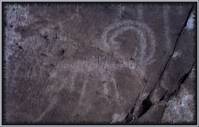

Inyo Zoology
The archaeologists have attempted to make the point that Inyo was a petroglyph site related to sheep and/or sheep hunting magic. The make the case based on a theory that the area was inhabited by big horn sheep. A proper examination is in order.
The area is arid. Little water is available, the nearest fresh water source is a river, some eight miles distant. This source has been almost dry for about the past hundred years. We must resort to reports of the early history of the valley to seek information of what it was like when they first arrived.
Nothing. The early Americans who occupied the Owens Valley said nothing about what animals were naturally present. They weren't hunters, although there was certainly some, they were cattle ranchers and farmers. The discovery of silver at Cerro Gordo and elsewhere brought in miners. It is as if the natural fauna was an insignificant factor. Which was probably true.
Spending many hours on the Inyo location covering all times of day and season has had its advantage. The animals I've seen on the site are representative of how it was in historic and pre-historic times. Lizards, ravens, desert finches, the occasional soaring raptor, a packrat, and one coyote are the animals I've seen on the site. Never a sheep.
I am not convinced big horn sheep are truly native. They well may be ancient stock gone feral. Genetic clues may exist, but so far, no one has considered the issue important enough to make a comparison to the probable North African sources.
Return to Science Applied to Inyo
© 2008The Equinox Project, All Rights Reserved. Compiled from the
contents of The Dawson Library
Created for and maintained by The Equinox Project Please email any comments, questions or suggestions to:
info4u@equinox-project.com
NOTE you must remove !!! from the suplied address before using.
Last Modified January 2010